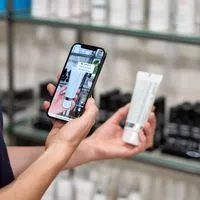Why We Need to Capture Value, Not Just Data
| Products & Solutions
:format(jpeg))
In our personal lives, we’re empowered with data at our fingertips on one device all day, every day. So why hasn’t the same access to actionable, real-time information spilled over into all areas of the business world?

Data democratization initiatives have not yet reached store associates, nurses, pharmacists, delivery drivers, field service engineers and many more frontline workers. Similarly, the interactive experience consumers are used to in e-commerce is still not replicated in brick-and-mortar stores.
And even though desk-based workers have the tools to analyze data, it’s an open secret that data from the frontline is often incomplete, inaccurate or outdated.
The overlooked problem of data capture
We believe a significant and overlooked cause of this data experience gap is the problem of data capture – how businesses collect, digitize and surface information from or about the physical world.
In our day-to-day lives, most data we access and act on is digitized – such as local weather, nearby drivers or restaurant availability.
But the situation for businesses is different. Almost all companies need to collect, analyze and act on data relating not only to digital but also tangible assets (such as inventory or equipment) and physical operations (such as warehouse and store operations, patient care or last mile delivery).
:format(jpeg))
Physical industries make up 75% of the world’s $100 trillion GDP. Yet they are still not fully digitized or connected.
Data capture has not modernized or kept pace with other elements of data management. Manual data collection processes and asynchronous ways to access data about physical assets still predominate.
Even where technology, such as handheld scanners, has been introduced to simplify data capture, it is generally confined to capturing one item at a time. Devices are typically company-owned, purpose-built, non-personalized and often shared by a number of employees.
This is why, today, we’re launching Capture Value, Not Data, a manifesto for smarter data capture.
We believe that, today, we have the technology to transform the tedious, inefficient, inaccurate, disjointed and hard-to-scale ways we capture data. And we believe reimagining how employees, customers and businesses interact with the physical world will deliver exponential efficiency gains and transformational employee and customer experiences in the next decade of tech.

Capture Value, Not Data
9 smart data capture principles to unlock the next level of business efficiency.
Transformation of physical industries will be the next technology boom
Tech investment is pivoting away from consumer applications and towards industries – such as retail, manufacturing, supply chain, healthcare and transportation – that focus on solving problems in the physical world.
Despite the chill winds currently blowing through tech investment, Silicon Valley investment firm Eclipse recently raised $1.2 billion for two new funds, both backing startups trying to modernize physical industries. G2 Venture Partners, one of Scandit’s investors, has a similar approach with an explicit focus on unlocking the potential of transformative technology in traditional industries.
Major disruptions over the last few years – Covid, geopolitical uncertainty, supply chain disruptions, labor shortages and sustainability pressures – have accelerated the drive to modernize physical industries and make them more efficient, scalable, resilient and profitable.
Equally important, technology maturity has lowered investment costs. Mobile and cloud computing, computer vision, artificial intelligence, augmented reality and more unlock new opportunities to connect physical industries – and the frontline workers who keep them running.
:format(jpeg))
The opportunity in modernizing data capture
We’ve heard extraordinary first-hand stories of the impact of the way we capture data today. A jewelry retailer, for example, told us that to manage product markdowns, field workers were emailed spreadsheets listing thousands of SKUs (stock keeping units) – and that data on what markdowns had been applied didn’t feed back to head office until months later.
Or how about the food delivery company that required its gig economy drivers to scan and verify IDs at the door for age-restricted goods? Unfortunately, it depended on an internet connection. If there was no mobile coverage, the driver had to ask the customer if they could use the customer’s home WiFi.
Broken data capture workflows like this are everywhere in physical industries, and the opportunity in modernizing them is huge.
Logistics errors, for example, cost the pharma sector alone a staggering $35 billion every year.
One of the key challenges is avoidable spoilage in the supply chain as a result of a lack of information needed to make the right decisions at the right moment. Modernizing processes such as scanning barcodes to track the movement of drugs and therapeutics makes them more than just a place where data is collected. They become a site where accessible, actionable, real-time insights are surfaced to reduce spoilage.
Capture value, not just data
The goal of smart data capture is to efficiently capture, extract, combine and analyze data from multiple sources (barcodes, text, IDs, objects), and instantly surface rich, actionable insights. Frontline workers get accessible insights at the moment of data collection, while desk-based decision makers have real-time visibility into processes such as store and warehouse operations.
A smart data capture strategy captures greater value by fundamentally reimagining how employees, customers and businesses interact with tangible assets and physical operations.
:format(jpeg))
Nearly 80% of American consumers, for example, point to knowledgeable staff as one of the most important elements of a positive customer experience. In our work with River Island, the UK retailer gave store associates smartphones, equipped with smart data capture enabled apps that surfaced real-time, on-the-spot insights. It dramatically improved both the customer and employee experience without the need to invest in extensive training.
Another example is the transition to a smart data capture app for order picking by Japan’s OK Corporation. When picking work was carried out manually by visually checking paper lists, it took about 5 seconds per item and there was a picking error rate of around 6% – meaning over 1 in 20 items were incorrectly picked. Using a smart data capture picking app reduced picking time to just 2 seconds and the error rate to near zero.
Capture Value, Not Data is a set of principles and a strategic roadmap that draw on the decade Scandit has spent uncovering smarter ways to capture data – from how to use technology to restore bandwidth and rehumanize employee experiences, to upskilling frontline workers, empowering customers, designing adaptable solutions that give data instant purpose and value and the essential role of UX.
Ready to join the smart data capture revolution and the next technology boom? It’s going to be quite a ride.

The Smart Data Capture Manifesto
Why capturing value, not just data, will define the next decade of innovation.